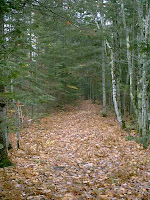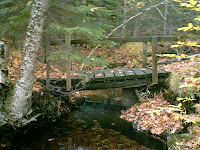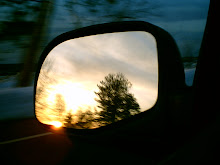 My autumn walks on the Tyoga Historical Pathway have taken a different turn. First, for two of the three walks I have not been alone. Second, I have been off-trail.
My autumn walks on the Tyoga Historical Pathway have taken a different turn. First, for two of the three walks I have not been alone. Second, I have been off-trail.The reason for two of the three walks was to gather information for an article about the trail. Here's what's happening:
- exact locations of Tyoga's buildings and rail line are being identified;
- the trail is being routinely cleared of brush and blow-downs;
- trees are being identified and some marked with name plates and numbers that will correspond to a brochure;
- birds in the area are being identified and catalogued;
- wild flowers and plants are being catalogued;
- and a book about the Tyoga Lumber Co. is in the works.
One interesting thing learned: Liquor was not commonly allowed in a lumber camp. Apparently, sawing down huge trees in the woods was deemed dangerous enough without throwing alcohol into the mix. But, now, if there was a town built up around and alongside the camp ... that was a different matter. Then, there could be alcohol. So could it be that the town of Tyoga existed simply to afford the lumberjacks a Saturday night toot?
The reason for the third walk was to get all that information out of my head and to get back to what I love about the trail - its remoteness, its mystery, its untold stories. As well, though, I needed to coalesce, to fit all this new information together with my old perceptions and figure out how to write the article, where to start.
The day of the third walk was the day of the first snow. It came down in sudden squalls like puffs of icy smoke. The few days preceding had been cold and rainy; now it seemed we were edging ever-so-slightly closer to winter, to November, to a change of season. In winter, Tyoga is hard to get to. Its access road is not plowed, and I do not know who, if anyone, goes out there on a snow machine or snow shoes or cross country skis. So on the day of the first snow, I knew that soon Tyoga would be buried, and I would not be walking the trail for a number of months.
 Tyoga is spectacular on a dark, snow swirly, late autumn day. The trail is damp, slick, and laden with leaves, an occasional bright splotch of red and vibrant green moss edge out the potential dreariness. Odd little Martian-like plants, wheat-colored, probably some kind of spindly mushroom, teeter up out of the thick moss, bobbing their heads, stretching an inch or two high. Hard crystals of snow, like pale glass beads, huddle in small depressions and pockets of leaves, massing together in coldness rather than warmth. I am struck, as always, by the amount of new growth that comes up from old growth - the ferns curling up out of jagged stumps, the moss and mushrooms that cover boulders and fallen trees and downed branches, the saplings that grow straight up out of a bed of rotting pine, the sheer mass of leaves underfoot, feeding it all, all I do see, all I don't see.
Tyoga is spectacular on a dark, snow swirly, late autumn day. The trail is damp, slick, and laden with leaves, an occasional bright splotch of red and vibrant green moss edge out the potential dreariness. Odd little Martian-like plants, wheat-colored, probably some kind of spindly mushroom, teeter up out of the thick moss, bobbing their heads, stretching an inch or two high. Hard crystals of snow, like pale glass beads, huddle in small depressions and pockets of leaves, massing together in coldness rather than warmth. I am struck, as always, by the amount of new growth that comes up from old growth - the ferns curling up out of jagged stumps, the moss and mushrooms that cover boulders and fallen trees and downed branches, the saplings that grow straight up out of a bed of rotting pine, the sheer mass of leaves underfoot, feeding it all, all I do see, all I don't see.
And this, I thought, you don't see in the city. In the city, you are not allowed to see that life springs from death. Or maybe just that the line between death and life is messier than we think. In the city, if a tree falls it is hauled away and its stump ground down or poisoned. Autumn leaves are blown into piles and carted away just moments after we revel in their beauty. And so we miss the true beauty, the fading of color, the drying, the decomposition and the slow emergence of life once again. Of course, things have to be kept orderly in a city, and in this, I'm sure, something is gained, but also, no doubt, something is lost.
One of the people I walked Tyoga with is a student at Northern Michigan University. She mentioned the book "Last Child in the Woods" by Richard Louv. Another was the man who a few years ago kindled fresh interest in the trail, who recruited people to clear brush, and who started investigating anew Tyoga's history. He told about being on the trail with a grandchild and encouraging him to use the blue "confidence markers" to stay on the trail - the same markers I was using this spring. With him and an archeologist (who was uncovering 100-year-old foundations) I went off-trail in Tyoga, and that surprised me. What is it about me, I wondered, that had me assuming one should not venture off the trail?
 On my third autumn walk in Tyoga, when I was solo, I did not hesitate to veer off-trail to explore whatever caught my eye - most likely the underside of the stump of a fallen tree - and with the snow squalling around me and winter coming, I felt an uncommon peace. A few days later, I wrote down this quote from "Last Child in the Woods," which Louv attributed to Bernard Berenson:
On my third autumn walk in Tyoga, when I was solo, I did not hesitate to veer off-trail to explore whatever caught my eye - most likely the underside of the stump of a fallen tree - and with the snow squalling around me and winter coming, I felt an uncommon peace. A few days later, I wrote down this quote from "Last Child in the Woods," which Louv attributed to Bernard Berenson:
"I had no need for words. It and I were one."
The reason for the third walk was to get all that information out of my head and to get back to what I love about the trail - its remoteness, its mystery, its untold stories. As well, though, I needed to coalesce, to fit all this new information together with my old perceptions and figure out how to write the article, where to start.
The day of the third walk was the day of the first snow. It came down in sudden squalls like puffs of icy smoke. The few days preceding had been cold and rainy; now it seemed we were edging ever-so-slightly closer to winter, to November, to a change of season. In winter, Tyoga is hard to get to. Its access road is not plowed, and I do not know who, if anyone, goes out there on a snow machine or snow shoes or cross country skis. So on the day of the first snow, I knew that soon Tyoga would be buried, and I would not be walking the trail for a number of months.
 Tyoga is spectacular on a dark, snow swirly, late autumn day. The trail is damp, slick, and laden with leaves, an occasional bright splotch of red and vibrant green moss edge out the potential dreariness. Odd little Martian-like plants, wheat-colored, probably some kind of spindly mushroom, teeter up out of the thick moss, bobbing their heads, stretching an inch or two high. Hard crystals of snow, like pale glass beads, huddle in small depressions and pockets of leaves, massing together in coldness rather than warmth. I am struck, as always, by the amount of new growth that comes up from old growth - the ferns curling up out of jagged stumps, the moss and mushrooms that cover boulders and fallen trees and downed branches, the saplings that grow straight up out of a bed of rotting pine, the sheer mass of leaves underfoot, feeding it all, all I do see, all I don't see.
Tyoga is spectacular on a dark, snow swirly, late autumn day. The trail is damp, slick, and laden with leaves, an occasional bright splotch of red and vibrant green moss edge out the potential dreariness. Odd little Martian-like plants, wheat-colored, probably some kind of spindly mushroom, teeter up out of the thick moss, bobbing their heads, stretching an inch or two high. Hard crystals of snow, like pale glass beads, huddle in small depressions and pockets of leaves, massing together in coldness rather than warmth. I am struck, as always, by the amount of new growth that comes up from old growth - the ferns curling up out of jagged stumps, the moss and mushrooms that cover boulders and fallen trees and downed branches, the saplings that grow straight up out of a bed of rotting pine, the sheer mass of leaves underfoot, feeding it all, all I do see, all I don't see.And this, I thought, you don't see in the city. In the city, you are not allowed to see that life springs from death. Or maybe just that the line between death and life is messier than we think. In the city, if a tree falls it is hauled away and its stump ground down or poisoned. Autumn leaves are blown into piles and carted away just moments after we revel in their beauty. And so we miss the true beauty, the fading of color, the drying, the decomposition and the slow emergence of life once again. Of course, things have to be kept orderly in a city, and in this, I'm sure, something is gained, but also, no doubt, something is lost.
One of the people I walked Tyoga with is a student at Northern Michigan University. She mentioned the book "Last Child in the Woods" by Richard Louv. Another was the man who a few years ago kindled fresh interest in the trail, who recruited people to clear brush, and who started investigating anew Tyoga's history. He told about being on the trail with a grandchild and encouraging him to use the blue "confidence markers" to stay on the trail - the same markers I was using this spring. With him and an archeologist (who was uncovering 100-year-old foundations) I went off-trail in Tyoga, and that surprised me. What is it about me, I wondered, that had me assuming one should not venture off the trail?
 On my third autumn walk in Tyoga, when I was solo, I did not hesitate to veer off-trail to explore whatever caught my eye - most likely the underside of the stump of a fallen tree - and with the snow squalling around me and winter coming, I felt an uncommon peace. A few days later, I wrote down this quote from "Last Child in the Woods," which Louv attributed to Bernard Berenson:
On my third autumn walk in Tyoga, when I was solo, I did not hesitate to veer off-trail to explore whatever caught my eye - most likely the underside of the stump of a fallen tree - and with the snow squalling around me and winter coming, I felt an uncommon peace. A few days later, I wrote down this quote from "Last Child in the Woods," which Louv attributed to Bernard Berenson:"I had no need for words. It and I were one."
Tyoga Trail: Part One
Tyoga Trail: Part Two



